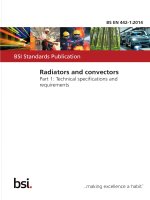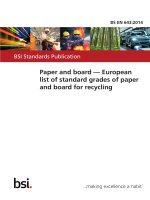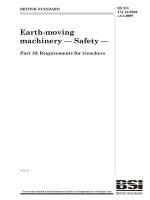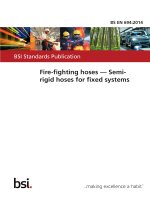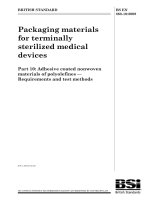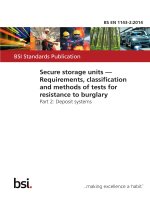Bsi bs en 16603 60 10 2014
Bạn đang xem bản rút gọn của tài liệu. Xem và tải ngay bản đầy đủ của tài liệu tại đây (1.55 MB, 60 trang )
BS EN 16603-60-10:2014
BSI Standards Publication
Space engineering — Control
performances
BS EN 16603-60-10:2014
BRITISH STANDARD
National foreword
This British Standard is the UK implementation of EN
16603-60-10:2014.
The UK participation in its preparation was entrusted to Technical
Committee ACE/68, Space systems and operations.
A list of organizations represented on this committee can be
obtained on request to its secretary.
This publication does not purport to include all the necessary
provisions of a contract. Users are responsible for its correct
application.
© The British Standards Institution 2014. Published by BSI Standards
Limited 2014
ISBN 978 0 580 84090 6
ICS 49.140
Compliance with a British Standard cannot confer immunity from
legal obligations.
This British Standard was published under the authority of the
Standards Policy and Strategy Committee on 30 September 2014.
Amendments issued since publication
Date
Text affected
BS EN 16603-60-10:2014
EN 16603-60-10
EUROPEAN STANDARD
NORME EUROPÉENNE
EUROPÄISCHE NORM
September 2014
ICS 49.140
English version
Space engineering - Control performances
Ingénierie spatiale - Performance de systèmes de contrôle
Raumfahrttechnik - Steuerungsleistung
This European Standard was approved by CEN on 1 March 2014.
CEN and CENELEC members are bound to comply with the CEN/CENELEC Internal Regulations which stipulate the conditions for giving
this European Standard the status of a national standard without any alteration. Up-to-date lists and bibliographical references concerning
such national standards may be obtained on application to the CEN-CENELEC Management Centre or to any CEN and CENELEC
member.
This European Standard exists in three official versions (English, French, German). A version in any other language made by translation
under the responsibility of a CEN and CENELEC member into its own language and notified to the CEN-CENELEC Management Centre
has the same status as the official versions.
CEN and CENELEC members are the national standards bodies and national electrotechnical committees of Austria, Belgium, Bulgaria,
Croatia, Cyprus, Czech Republic, Denmark, Estonia, Finland, Former Yugoslav Republic of Macedonia, France, Germany, Greece,
Hungary, Iceland, Ireland, Italy, Latvia, Lithuania, Luxembourg, Malta, Netherlands, Norway, Poland, Portugal, Romania, Slovakia,
Slovenia, Spain, Sweden, Switzerland, Turkey and United Kingdom.
CEN-CENELEC Management Centre:
Avenue Marnix 17, B-1000 Brussels
© 2014 CEN/CENELEC All rights of exploitation in any form and by any means reserved
worldwide for CEN national Members and for CENELEC
Members.
Ref. No. EN 16603-60-10:2014 E
BS EN 16603-60-10:2014
EN 16603-60-10:2014 (E)
Table of contents
Foreword .................................................................................................................... 5
Introduction................................................................................................................ 6
1 Scope ....................................................................................................................... 7
2 Normative references ............................................................................................. 8
3 Terms, definitions and abbreviated terms............................................................ 9
3.1
Terms from other standards......................................................................................9
3.2
Terms specific to the present standard .....................................................................9
3.3
Abbreviated terms...................................................................................................14
4 Performance requirements and budgeting ........................................................ 15
4.1
4.2
Specifying a performance requirement ................................................................... 15
4.1.1
Overview ...................................................................................................15
4.1.2
Elements of a performance requirement ................................................... 16
4.1.3
Elements of a knowledge requirement ...................................................... 16
4.1.4
Probabilities and statistical interpretations................................................. 17
Use of error budgeting to assess compliance ......................................................... 17
4.2.1
Scope and limitations ................................................................................17
4.2.2
Identification and characterisation of contributors ...................................... 18
4.2.3
Combination of contributors ...................................................................... 19
4.2.4
Comparison with requirement ................................................................... 21
5 Stability and robustness specification and verification for linear systems .... 23
2
5.1
Overview ................................................................................................................23
5.2
Stability and robustness specification ..................................................................... 24
5.2.1
Uncertainty domains .................................................................................24
5.2.2
Stability requirement .................................................................................26
5.2.3
Identification of checkpoints ...................................................................... 26
5.2.4
Selection and justification of stability margin indicators ............................. 27
5.2.5
Stability margins requirements .................................................................. 27
5.2.6
Verification of stability margins with a single uncertainty domain ............... 28
BS EN 16603-60-10:2014
EN 16603-60-10:2014 (E)
5.2.7
Verification of stability margins with reduced and extended
uncertainty domains ..................................................................................28
Annex A (informative) Use of performance error indices ................................... 29
A.1
A.2
Formulating error requirements...............................................................................29
A.1.1
More about error indices ........................................................................... 29
A.1.2
Statistical interpretation of requirements ................................................... 30
A.1.3
Knowledge requirements........................................................................... 32
A.1.4
Specifying the timescales for requirements ............................................... 32
More about performance error budgets................................................................... 34
A.2.1
When to use an error budget..................................................................... 34
A.2.2
Identifying and quantifying the contributing errors ..................................... 35
A.2.3
Combining the errors.................................................................................36
A.2.4
Comparison with requirements .................................................................. 38
Annex B (informative) Inputs to an error budget .................................................. 40
B.1
Overview ................................................................................................................40
B.2
Bias errors ..............................................................................................................41
B.3
Random errors........................................................................................................42
B.4
Periodic errors (short period) ..................................................................................44
B.5
Periodic errors (long period) ...................................................................................44
B.6
Distributions of ensemble parameters ..................................................................... 45
B.7
Using the mixed statistical distribution .................................................................... 48
Annex C (informative) Worked example ................................................................ 49
C.1
Scenario and requirements .....................................................................................49
C.2
Assessing the contributing errors ............................................................................ 50
C.3
Compiling the pointing budgets ...............................................................................52
Annex D (informative) Correspondence with the pointing error handbook ....... 54
References ............................................................................................................... 55
Bibliography............................................................................................................. 56
Figures
Figure A-1 : Example showing the APE, MPE and RPE error indices ................................... 30
Figure A-2 : Example showing the PDE and PRE error indices ............................................ 30
Figure A-3 : Example of a statistical ensemble of errors. ...................................................... 31
Figure A-4 : The different ways in which a requirement for P(|ε|<1º) > 0,9 can be met ......... 32
Figure A-5 : Illustration of how the statistics of the pointing errors differ depending on
which statistical interpretation is used ................................................................ 32
3
BS EN 16603-60-10:2014
EN 16603-60-10:2014 (E)
Figure C-1 : Scenario example .............................................................................................50
Tables
Table B-1 : Parameters whose distributions are assessed for the different pointing error
indices (knowledge error indices are similar) ...................................................... 41
Table B-2 : Budget contributions from bias errors, where B represents the bias ................... 42
Table B-3 : Budget contributions from zero mean Gaussian random errors .......................... 43
Table B-4 : Uniform Random Errors (range 0-C) .................................................................. 43
Table B-5 : Budget contributions for periodic errors (low period sinusoidal) .......................... 44
Table B-6 : Budget contributions for periodic errors (long period sinusoidal) ........................ 45
Table B-7 : Some common distributions of ensemble parameters and their properties ......... 47
Table C-1 : Example of contributing errors, and their relevant properties ............................. 51
Table C-2 : Example of distribution of the ensemble parameters .......................................... 52
Table C-3 : Example of pointing budget for the APE index ................................................... 53
Table C-4 : Example of pointing budget for the RPE index ................................................... 53
Table D-1 : Correspondence between Pointing error handbook and ECSS-E-ST-60-10
indicators............................................................................................................54
4
BS EN 16603-60-10:2014
EN 16603-60-10:2014 (E)
Foreword
This document (EN 16603-60-10:2014) has been prepared by Technical
Committee CEN/CLC/TC 5 “Space”, the secretariat of which is held by DIN.
This standard (EN 16603-60-10:2014) originates from ECSS-E-ST-60-10C.
This European Standard shall be given the status of a national standard, either
by publication of an identical text or by endorsement, at the latest by March
2015, and conflicting national standards shall be withdrawn at the latest by
March 2015.
Attention is drawn to the possibility that some of the elements of this document
may be the subject of patent rights. CEN [and/or CENELEC] shall not be held
responsible for identifying any or all such patent rights.
This document has been prepared under a mandate given to CEN by the
European Commission and the European Free Trade Association.
This document has been developed to cover specifically space systems and has
therefore precedence over any EN covering the same scope but with a wider
domain of applicability (e.g. : aerospace).
According to the CEN-CENELEC Internal Regulations, the national standards
organizations of the following countries are bound to implement this European
Standard: Austria, Belgium, Bulgaria, Croatia, Cyprus, Czech Republic,
Denmark, Estonia, Finland, Former Yugoslav Republic of Macedonia, France,
Germany, Greece, Hungary, Iceland, Ireland, Italy, Latvia, Lithuania,
Luxembourg, Malta, Netherlands, Norway, Poland, Portugal, Romania,
Slovakia, Slovenia, Spain, Sweden, Switzerland, Turkey and the United
Kingdom.
5
BS EN 16603-60-10:2014
EN 16603-60-10:2014 (E)
Introduction
This standard focuses on the specific issues raised by managing performance
aspects of control systems in the frame of space projects. It provides a set of
normative definitions, budget rules, and specification templates applicable
when developing general control systems.
The standard is split up in two main clauses, respectively dealing with:
•
Performance error indices and analysis methods.
•
Stability and robustness specification and verification for linear systems.
This document constitutes the normative substance of the more general and
informative handbook on control performance, issued in the frame of the E-6010 ECSS working group. If clarifications are necessary (on the concepts, the
technical background, the rationales for the rules for example) the readers
should refer to the handbook.
NOTE
6
It is not intended to substitute to textbook material
on automatic control theory, neither in this
standard nor in the associated handbook. The
readers and the users are assumed to possess
general knowledge of control system engineering
and its applications to space missions.
BS EN 16603-60-10:2014
EN 16603-60-10:2014 (E)
1
Scope
This standard deals with control systems developed as part of a space project. It
is applicable to all the elements of a space system, including the space segment,
the ground segment and the launch service segment.
It addresses the issue of control performance, in terms of definition,
specification, verification and validation methods and processes.
The standard defines a general framework for handling performance indicators,
which applies to all disciplines involving control engineering, and which can be
applied as well at different levels ranging from equipment to system level. It
also focuses on the specific performance indicators applicable to the case of
closed-loop control systems – mainly stability and robustness.
Rules are provided for combining different error sources in order to build up a
performance error budget and use this to assess the compliance with a
requirement.
NOTE 1
Although designed to be general, one of the major
application field for this Standard is spacecraft
pointing. This justifies why most of the examples
and illustrations are related to AOCS problems.
NOTE 2
Indeed the definitions and the normative clauses
of this Standard apply to pointing performance;
nevertheless fully specific pointing issues are not
addressed here in detail (spinning spacecraft cases
for example). Complementary material for
pointing error budgets can be found in ECSS-EHB-60-10.
NOTE 3
For their own specific purpose, each entity (ESA,
national agencies, primes) can further elaborate
internal
documents,
deriving
appropriate
guidelines and summation rules based on the top
level clauses gathered in this ECSS-E-ST-60-10
standard.
This standard may be tailored for the specific characteristic and constrains of a
space project in conformance with ECSS-S-ST-00.
7
BS EN 16603-60-10:2014
EN 16603-60-10:2014 (E)
2
Normative references
The following normative documents contain provisions which, through
reference in this text, constitute provisions of this ECSS Standard. For dated
references, subsequent amendments to, or revision of any of these publications
do not apply, However, parties to agreements based on this ECSS Standard are
encouraged to investigate the possibility of applying the more recent editions of
the normative documents indicated below. For undated references, the latest
edition of the publication referred to applies.
EN reference
Reference in text
Title
EN 16601-00-01
ECSS-S-ST-00-01
ECSS System – Glossary of terms
8
BS EN 16603-60-10:2014
EN 16603-60-10:2014 (E)
3
Terms, definitions and abbreviated terms
3.1
Terms from other standards
For the purpose of this Standard, the terms and definitions from ECSS-S-ST-00-01
apply, in particular for the following terms:
error
performance
uncertainty
3.2
Terms specific to the present standard 1
3.2.1
absolute knowledge error (AKE)
instantaneous value of the knowledge error at any given time
3.2.2
NOTE 1
This is expressed by:
NOTE 2
See annex A.1.3 for defining requirements on the
knowledge error.
AKE (t ) = eK (t )
absolute performance error (APE)
instantaneous value of the performance error at any given time
NOTE
3.2.3
This is expressed by:
APE (t ) = eP (t )
error index
parameter isolating a particular aspect of the time variation of a performance
error or knowledge error
NOTE 1
1
A performance error index is applied to the
difference between the target (desired) output of
the system and the actual system output.
As a preliminary note, the error signals introduced in clause 3.2 are very general. They represent any type of physical
quantity (e.g. attitude, temperature, pressure, position). According to the situation and to the nature of the control system,
they are scalar or multi-dimensional.
9
BS EN 16603-60-10:2014
EN 16603-60-10:2014 (E)
3.2.4
NOTE 2
A knowledge error index is applied to the
difference between the actual output of the system
and the known (estimated) system output.
NOTE 3
The most commonly used indices are defined in
this chapter (APE, RPE, AKE etc.). The list is not
limitative.
individual error source
elementary physical characteristic or process originating from a well-defined
source which contributes to a performance error or a performance knowledge
error
NOTE
3.2.5
For example sensor noise, sensor bias, actuator
noise, actuator bias, disturbance forces and torques
(e.g. microvibrations, manoeuvres, external or
internal subsystem motions), friction forces and
torques, misalignments, thermal distortions,
assembly distortions, digital quantization, control
law performance (steady state error), jitter, etc.
knowledge error
difference between the known (estimated) output of the system and the actual
achieved output
3.2.6
NOTE 1
It is denoted by eK.
NOTE 2
Usually this is time dependent.
NOTE 3
Sometimes
confusingly
referred
to
as
“measurement error”, though in fact the concept is
more general than direct measurement.
NOTE 4
Depending upon the system, different quantities
can be relevant for parameterising the knowledge
error, in the same way as for the performance
error. A degree of judgement is used to decide
which is most appropriate.
NOTE 5
For example: the difference between the actual and
the known orientation of a frame can be
parameterised using the Euler angles for the frame
transformation or the angle between the actual and
known orientation of a particular vector within
that frame.
mean knowledge error (MKE)
mean value of the knowledge error over a specified time interval
NOTE 1
This is expressed by:
MKE (∆t )= eK (∆t )
=
10
1
eK (t ) dt
∆t ∆∫t
BS EN 16603-60-10:2014
EN 16603-60-10:2014 (E)
NOTE 2
3.2.7
See annex A.1.4 for discussion of how to specify
the interval ∆t, and annex A.1.3 for defining
requirements on the knowledge error.
mean performance error (MPE)
mean value of the performance error over a specified time interval
NOTE 1
This is expressed by:
MPE (∆t ) = eP (∆t )
=
NOTE 2
3.2.8
1
eP (t ) dt
∆t ∆∫t
See annex A.1.4 for discussion of how to specify
the interval ∆t .
performance drift error (PDE)
difference between the means of the performance error taken over two time
intervals within a single observation period
NOTE 1
This is expressed by:
PDE (∆t1 , ∆t2 ) = eP (∆t2 ) − eP (∆t1 )
=
3.2.9
1
1
eP (t ) dt −
eP (t ) dt
∫
∆t2 ∆t2
∆t1 ∆∫t1
NOTE 2
Where the time intervals ∆t1 and ∆t2 are separated
by a non-zero time interval ∆tPDE.
NOTE 3
The durations of ∆t1 and ∆t2 are sufficiently long to
average out short term contributions. Ideally they
have the same duration. See annex A.1.4 for
further discussion of the choice of ∆t1 , ∆t2, ∆tPDE.
NOTE 4
The two intervals ∆t1 and ∆t2 are within a single
observation period
performance error
difference between the target (desired) output of the system and the actual
achieved output
NOTE 1
It is denoted by eP.
NOTE 2
Usually this is time dependent.
NOTE 3
Depending upon the system, different quantities
can be relevant for parameterising the
performance error. A degree of judgement is used
to decide which is most appropriate.
NOTE 4
For example: The difference between the target
and actual orientation of a frame can be
parameterised using the Euler angles for the frame
transformation or the angle between the target and
actual orientation of a particular vector within that
frame.
11
BS EN 16603-60-10:2014
EN 16603-60-10:2014 (E)
3.2.10
performance reproducibility error (PRE)
difference between the means of the performance error taken over two time
intervals within different observation periods
NOTE 1
This is expressed by:
PRE (∆t1 , ∆t2 ) = eP (∆t2 ) − eP (∆t1 )
=
3.2.11
1
1
eP (t ) dt −
eP (t ) dt
∫
∆t2 ∆t2
∆t1 ∆∫t1
NOTE 2
Where the time intervals ∆t1 and ∆t2 are separated
by a time interval ∆tPRE.
NOTE 3
The durations of ∆t1 and ∆t2 are sufficiently long to
average out short term contributions. Ideally they
have the same duration. See annex A.1.4 for
further discussion of the choice of ∆t1, ∆t2, ∆tPRE.
NOTE 4
The two intervals ∆t1 and ∆t2 are within different
observation periods
NOTE 5
The mathematical definitions of the PDE and PRE
indices are identical. The difference is in the use:
PDE is used to quantify the drift in the
performance error during a long observation,
while PRE is used to quantify the accuracy to
which it is possible to repeat an observation at a
later time.
relative knowledge error (RKE)
difference between the instantaneous knowledge error at a given time, and its
mean value over a time interval containing that time
NOTE 1
This is expressed by:
RKE (t , ∆=
t ) eK (t ) − eK (∆t )
= eK (t ) −
NOTE 2
3.2.12
1
eK (t ) dt
∆t ∆∫t
t ∈ ∆t
As stated here the exact relationship between t and
∆t is not well defined. Depending on the system it
can be appropriate to specify it more precisely: e.g.
t is randomly chosen within ∆t, or t is at the end of
∆t. See annex A.1.4 for discussion of how to specify
the interval ∆t, and annex A.1.3 for defining
requirements on the knowledge error.
relative performance error (RPE)
difference between the instantaneous performance error at a given time, and its
mean value over a time interval containing that time
NOTE 1
This is expressed by:
RPE (t , ∆t=
) eP (t ) − eP (∆t )
= eP (t ) −
12
1
eP (t ) dt
∆t ∆∫t
t ∈ ∆t
BS EN 16603-60-10:2014
EN 16603-60-10:2014 (E)
NOTE 2
3.2.13
As stated here the exact relationship between t and
∆t is not well defined. Depending on the system it
can be appropriate to specify it more precisely: e.g.
t is randomly chosen within ∆t, or t is at the end of
∆t. See annex A.1.4 for further discussion
robustness
ability of a controlled system to maintain some performance or stability
characteristics in the presence of plant, sensors, actuators and/or environmental
uncertainties
3.2.14
NOTE 1
Performance robustness is the ability to maintain
performance in the presence of defined bounded
uncertainties.
NOTE 2
Stability robustness is the ability to maintain
stability in the presence of defined bounded
uncertainties.
stability
ability of a system submitted to bounded external disturbances to remain
indefinitely in a bounded domain around an equilibrium position or around an
equilibrium trajectory
3.2.15
stability margin
maximum excursion of some parameters describing a given control system for
which the system remains stable
NOTE
3.2.16
The most frequent stability margins defined in
classical control design are the gain margin, the
phase margin, the modulus margin, and – less
frequently – the delay margins (see Clause 5 of this
standard)
statistical ensemble
set of all physically possible combinations of values of parameters which
describe a control system
NOTE
For example: Considering the attitude dynamics
of a spacecraft, these parameters include the mass,
inertias, modal coupling factors, eigenfrequencies
and damping ratios of the appendage modes, the
standard deviation of the sensor noises etc., that
means all physical parameters that potentially
have a significant on the performance of the
system.
13
BS EN 16603-60-10:2014
EN 16603-60-10:2014 (E)
3.3
Abbreviated terms
The following abbreviated terms are defined and used within this document:
14
Abbreviation
Meaning
AKE
absolute knowledge error
APE
absolute performance error
LTI
linear time invariant
MIMO
multiple input – multiple output
MKE
mean knowledge error
MPE
mean performance error
PDE
performance drift error
probability density function
PRE
performance reproducibility error
RKE
relative knowledge error
RMS
root mean square
RPE
relative performance error
RSS
root sum of squares
SISO
single input – single output
BS EN 16603-60-10:2014
EN 16603-60-10:2014 (E)
4
Performance requirements and budgeting
4.1
Specifying a performance requirement
4.1.1
Overview
For the purposes of this standard, a performance requirement is a specification
that the output of the system does not deviate by more than a given amount
from the target output. For example, it can be requested that the boresight of a
telescope payload does not deviate by more than a given angle from the target
direction.
In practice, such requirements are specified in terms of quantified probabilities.
Typical requirements seen in practice are for example:
•
“The instantaneous half cone angle between the actual and desired payload
boresight directions shall be less than 1,0 arcmin for 95 % of the time”
•
“Over a 10 second integration time, the Euler angles for the transformation
between the target and actual payload frames shall have an RPE less than 20
arcsec at 99 % confidence, using the mixed statistical interpretation.”
•
“APE(ε) < 2,5 arcmin (95 % confidence, ensemble interpretation), where
ε = arccos(xtarget.xactual)”
Although given in different ways, these all have a common mathematical form:
prob ( X < X max ) ≥ PC
To put it into words, the physical quantity X to be constrained is defined and
a maximum value X max is specified, as well as the probability PC that the
magnitude of
X is smaller than X max .
Since there are different ways to interpret the probability, the applicable
statistical interpretation is also given.
These concepts are discussed in Annex A.
15
BS EN 16603-60-10:2014
EN 16603-60-10:2014 (E)
4.1.2
a.
Elements of a performance requirement
The specification of a performance shall consist of:
1.
The quantities to be constrained.
NOTE 1
This is usually done specifying the appropriate
indices (APE, MPE, RPE, PDE, PRE) as defined in
3.2.
NOTE 2
All the elements needed to fully describe the
constrained quantities are listed there; for example,
the associated timescales for MPE or RPE.
2.
The allowed range for each of these quantities.
3.
The probability that each quantity lies within the specified range.
NOTE
4.
4.1.3
a.
The interpretation of this probability.
NOTE 1
This is often referred to as the “statistical
interpretation”. See annex A.1.2
NOTE 2
The way to specify the statistical interpretation is
described in 4.1.4.2.
Elements of a knowledge requirement
When specifying a requirement on the knowledge of the performance,
the following elements shall be specified:
1.
The quantities to be constrained.
NOTE 1
This is usually done specifying the appropriate
indices (AKE, MKE, RKE) as defined in 3.2.
NOTE 2
All the elements needed to fully describe the
constrained quantities are listed there; for example,
the associated timescales for MKE or RKE.
2.
The allowed range for each of these quantities.
3.
The probability that each quantity lies within the specified range.
NOTE
4.
5.
This is often called the confidence level. See 4.1.4;
The interpretation of this probability.
NOTE 1
This is often referred to as the “statistical
interpretation”. See annex A.1.2
NOTE 2
The way to specify the statistical interpretation is
described in 4.1.4.2.
The conditions under which the requirement applies.
NOTE
16
This is often called the confidence level. See 4.1.4;
These conditions can be that the requirement refers
to the state of knowledge on-board, on ground
before post processing, or after post processing.
This is explained further in annex A.1.3.
BS EN 16603-60-10:2014
EN 16603-60-10:2014 (E)
4.1.4
Probabilities and statistical interpretations
4.1.4.1
Specifying probabilities
a.
In the general case all probabilities shall be expressed as fractions or as
percentages.
b.
Using the ‘nσ’ notation for expressing probabilities shall be restricted to
cases where the hypothesis of Gaussian distribution holds.
4.1.4.2
a.
NOTE 1
For example: in the general case PC = 0,95 or PC =
95 % are both acceptable, but PC = 2σ is not. Indeed
the ‘nσ’ format assumes a Gaussian distribution;
using this notation for a general statistical
distribution can cause wrong assumptions to be
made. For a Gaussian the 95 % (2σ) bound is twice
as far from the mean as the 68 % (1σ) bound, but
this relation does not hold for a general
distribution.
NOTE 2
Upon certain conditions the assumption of
Gaussian distribution is not to be excluded a
priory. For example the central limit theorem
states that the sum of a large number of
independent and identically-distributed random
variables is approximately normally distributed.
Specifying statistical interpretations
When specifying the statistical interpretation (4.1.2a.4), it shall be stated
which variables are varied across their possible ranges and which are set
to worst case.
NOTE
4.2
The most commonly used interpretations
(temporal, ensemble, mixed) are extreme cases and
can be inappropriate in some situations. Annex
A.1.2 discusses this further.
Use of error budgeting to assess compliance
4.2.1
Scope and limitations
A common way to assess compliance with a performance specification is to
compile an error budget for that system. This involves taking the known
information about the sources contributing them to the total error, then
combining them to estimate the behaviour of the overall performance error,
which can then be compared to the original requirement.
It is important to emphasise that the common methods of budgeting (in
particular those developed by Clause 4.2.3) are approximate only, and therefore
used with care. They are based on the assumption from the central limit
theorem that the distribution of the total error is Gaussian, and therefore
completely specified by its mean and variance per axis. This approximation is
17
BS EN 16603-60-10:2014
EN 16603-60-10:2014 (E)
appropriate in most situations, but, like all approximations, it is used it with
care. It is not possible to give quantitative limits on its domain of validity; a
degree of engineering judgement is involved.
Further discussion is given in annex A.2.1.
NOTE
4.2.2
Identification and characterisation of
contributors
4.2.2.1
Identification of contributing errors
a.
All significant error source contributing to the budget shall be listed.
b.
A justification for neglecting some potential contributors should be
maintained in the error budget report document.
NOTE
4.2.2.2
This is to show that they have been considered.
They can be listed separately if preferred.
Classification of contributing errors
a.
The contributing errors shall be classified into groups.
b.
The classification criteria shall be stated.
c.
All errors which can potentially be correlated with each other shall be
classified in the same group.
d.
A group shall not contain a mixture of correlated and uncorrelated
errors.
4.2.2.3
a.
NOTE 1
For example: a common classification is to
distinguish between biases, random errors,
harmonic errors with various periods, etc.
NOTE 2
The period of variation (short term, long term,
systematic) is not a sufficient classification
criterion, as by itself it provides no insight into
whether or not the errors can be correlated.
Characterisation of contributing errors
For each error source, a mean and standard deviation shall be allocated
along each axis.
NOTE 1
18
In general error budgeting is not sufficient to
extensively demonstrate the final performance of a
complex control system. The performance
validation process also involves appropriate,
detailed simulation campaign using Monte-Carlo
techniques, or worst-case simulation scenarios.
The mean and standard deviation differ
depending on which error indices are being
assessed.
Guidelines
for
obtaining
these
parameters are given in Annex B.
BS EN 16603-60-10:2014
EN 16603-60-10:2014 (E)
4.2.2.4
a.
NOTE 2
The variance can be considered equivalent to the
standard deviation, as they are simply related. The
root sum square (RSS) value is only equivalent in
the case that the mean can be shown to be zero.
NOTE 3
Further information about the shape of the
distribution is only needed in the case that the
approximations
used
for
budgeting
are
insufficient.
Scale factors of contributing errors
The scale factors with which each error contributes to the total error shall
be defined.
4.2.3
NOTE 1
Clause 4.2.3 clarifies this statement further.
NOTE 2
The physical nature of the scale factors depends
upon the nature of the system.
NOTE 3
For example: For spacecraft attitude (pointing)
errors, specify the frame in which the error acts, as
the frame transformations are effectively the scale
factors for this case.
Combination of contributors
a.
If the total error is a linear combination of individual contributing errors,
classified in one or several groups according to 4.2.2.2, the mean of the
total error shall be computed using a linear sum over the means of all the
individual contributing errors.
b.
If the total error is a linear combination of individual contributing errors,
classified in one or several groups according to 4.2.2.2, the standard
deviation of a group of correlated or potentially correlated errors shall be
computed using a linear sum over the standard deviations of the
individual errors belonging to this group.
c.
If the total error is a linear combination of individual contributing errors,
classified in one or several groups according to 4.2.2.2, the standard
deviation of a group of uncorrelated errors shall be computed using a
root sum square law over the standard deviations of the individual errors
belonging to this group.
d.
If the total error is a linear combination of individual contributing errors,
classified in one or several groups according to 4.2.2.2, the standard
deviation of the total error shall be computed using a root sum square
law over the standard deviations of the different error groups.
NOTE 1
etotal is a linear combination of the
individual contributing errors ei if it is
The total error
mathematically expressed by:
N
etotal = ∑ ci ei
i =1
19
BS EN 16603-60-10:2014
EN 16603-60-10:2014 (E)
ci are the scale factors introduced in
where the
4.2.2.4.
NOTE 2
Although this is not the most general case, in
practice a wide variety of commonly encountered
scenarios verify the condition of linear
combination. For example in the small angle
approximation the total transformation between
two nominally aligned frames takes this form: see
annex A.2.3 for more details.
NOTE 3
In the case where the total error is a vector (for
example the three Euler angles between frames) it
is possible to restate it as a set of scalar errors.
NOTE 4
According to 4.2.3a the mean
µtotal
of the total
error is mathematically expressed by:
N
µ total = ∑ ci µ i
i =1
where
NOTE 5
µi
is the mean of the error
ei
According to 4.2.3b a general upper bound of the
standard deviation
σ group
of a group of potentially
correlated errors is mathematically expressed by:
N group
σ group ≤
∑c σ
i
i
i =1
where σ i is the standard deviation of the error
The actual value of σ group
ei .
is obtained by
investigating the correlation conditions case by case.
NOTE 6
According to 4.2.3c. the standard deviation
σ group
of a group of uncorrelated errors is mathematically
expressed by:
N group
σ group =
∑c σ
2
i
2
i
i =1
where
NOTE 7
σi
is the standard deviation of the error
According to 4.2.3d the standard deviation
ei
σ total
of the total error is mathematically expressed by:
σ total =
∑σ
2
group
groups
NOTE 8
20
Alternative summation rules can be found in the
literature, often based on linearly summing the
standard deviations of different frequency classes.
These rules have no mathematical basis and are
likely to be overly conservative. They are therefore
not recommended. Annex A.2.1 discusses this
further.
BS EN 16603-60-10:2014
EN 16603-60-10:2014 (E)
4.2.4
Comparison with requirement
4.2.4.1
Requirements given on an error
a.
If the total error is a linear combination of individual contributing errors,
the following condition shall be met to ensure that the budget is
compliant with the specification:
µtotal + nPσ total ≤ X max
Where
µtotal
is the mean of the total error according to 4.2.3.a.
nP is a positive scalar defined such that for a Gaussian distribution
the nP -σ confidence level encloses the probability PC given in
the specification.
σ total
is the standard deviation of the total error according to
4.2.3.b, 4.2.3.c, and 4.2.3.d.
X max is the maximum range for the total error, given in the
specification.
NOTE 1
This condition is based on the assumption that the
total combined distribution has Gaussian or close
to Gaussian shape. This is not always the case: see
annex A.2.1 for more details.
NOTE 2
This condition is conservative.
NOTE 3
For example: This applies to the case of
“rotational” pointing errors, in which separate
requirements are given for each of the Euler angles
between two nominally, aligned frames.
4.2.4.2
Requirements given on the RSS of two errors
4.2.4.2.1
General case
a.
If the total error
errors
e=
total
eA2 + eB2 is a quadratic sum of two independent
eA and eB , each of which being a linear combination of individual
contributing errors, the following condition shall be met to ensure that
the budget is compliant with the specification:
µ A2 + µ B2 + nP σ A2 + σ B2 ≤ X max
where
µA
and
µA
are the means of the two errors
eA and eB .
nP is a positive scalar defined such that for a Gaussian distribution
the nP -σ confidence level encloses the probability PC given in
the specification.
21
BS EN 16603-60-10:2014
EN 16603-60-10:2014 (E)
σA
X max is the maximum value for the total error, given in the
and
σB
are the standard deviations of the two errors
eA and eB .
specification.
NOTE 1
This condition is extremely conservative and is not
an exact formula. See annex A.2.4 for more details.
NOTE 2
This applies to the case of “directional” pointing
errors, in which a requirement is given on the
angle between the nominal direction of an axis and
its actual direction. In this case eA and eB are the
Euler angles perpendicular to this axis.
4.2.4.2.2
a.
Specific case
If the total error
etotal is a quadratic sum of two errors eA and eB , each of
which being a linear combination of individual contributing errors, and if
the following additional conditions are verified:
σ A >> µ A , σ B >> µ B , σ A ≈ σ B
the following condition shall be met to ensure that the budget is
compliant with the specification:
max (σ A ,σ B ) − 2log (1 − PC ) ≤ X max
where
µA
nP is a positive scalar defined such that for a Gaussian distribution
the
and
µB
are the means of the two errors
eA and eB .
nP -σ confidence level encloses the probability PC given in
the specification.
σA
X max is the maximum value for the total error, given in the
and
σB
are the standard deviations of the two errors
eA and eB .
specification.
22
‘log’ is the natural logarithm (base e)
NOTE 1
This condition is based on the properties of a
Rayleigh distribution. It is a less conservative
formula than the general case (4.2.4.2.1) – see
annex A.2.4 for more details.
NOTE 2
This applies to the case of “directional” pointing
errors in which the errors on the perpendicular
axes are similar.
BS EN 16603-60-10:2014
EN 16603-60-10:2014 (E)
5
Stability and robustness specification and
verification for linear systems
5.1
Overview
When dealing with closed-loop control systems, the question arises of how to
specify the stability and robustness properties of the system in the presence of
an active feedback.
For linear systems, stability is an intrinsic performance property. It does not
depend on the type and level of the inputs; it is directly related to the internal
nature of the system itself.
For an active system, a quantified knowledge of uncertainties within the system
enables to:
•
Design a better control coping with actual uncertainties.
•
Identify the worst case performance criteria or stability margins of a
given controller design and the actual values of uncertain parameters
leading to this worst case.
In this domain the state-of-the-art for stability specification is not fully
satisfactory. A traditional rule exists, going back to the times of analogue
controllers, asking for a gain margin better than 6 dB, and a phase margin better
than 30°. But this formulation proves insufficient, ambiguous or even
inappropriate for many practical situations:
•
MIMO systems cannot be properly handled with this rule, which applies
to SISO cases exclusively.
•
There is no reference to the way these margins are adapted (or not) in the
presence of system uncertainties; do the 6 dB / 30° requirement still hold
in the event of numerical dispersions on the physical parameters?
•
In some situations, it is well known to control engineers that gain and
phase margins are not sufficient to characterise robustness; additional
indicators (such as modulus margins) can be required.
•
In the next clauses a more consistent method is proposed for specifying
stability and robustness. It is intended to help to formulate clear
unambiguous requirements in an appropriate manner, and the supplier
to understand what is necessary with no risk of ambiguity.
NOTE 1
This standard focuses on the structure of the
requirement. The type of margins, the numerical
values for margins, or even the pertinence of
23


